
by Gideon Marcus
Mission Failures
It's been a tremendous month for fans of the Space Race. I won't go into detail here, since we already published an article on Voskhod 2, Gemini 3, etc. just last week.
Thanks to Newton's Third Law, or perhaps the Second Law of Thermodynamics, or maybe Finagle/Murphy's First, the science fiction mags have been correspondingly lousy. If we call the 3-star threshold making it into orbit, then virtually every SF digest this month was a suborbital dud. John Campbell's Analog, which led the pack last month, is among the damp squibs this month.
T Minus Zero
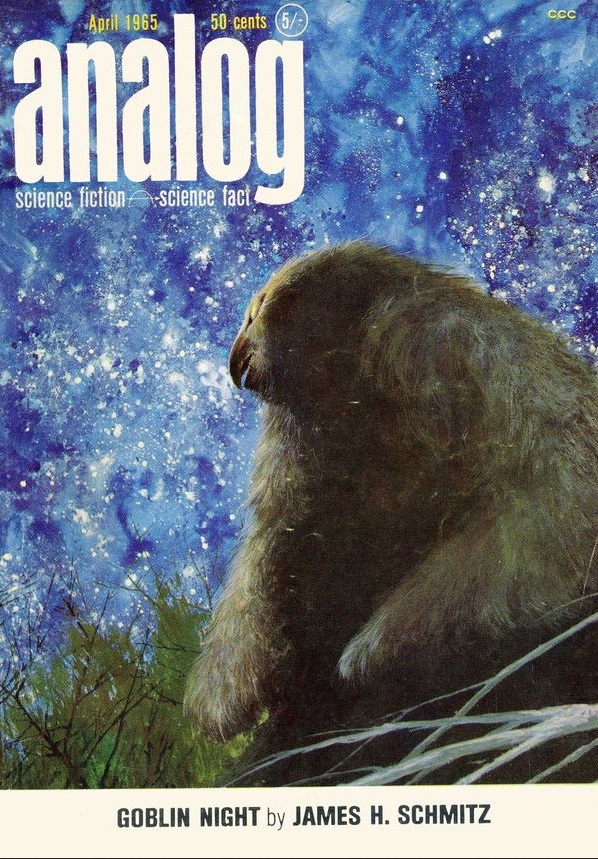
by John Schoenherr
Goblin Night, by James H. Schmitz

by John Schoenherr
15-year old telepath, Telzey Amberdon, is back. On a camping trip with her class in Melno Park on the planet of Orado, she makes psychic contact with a handicapped, housebound fellow named Robane. He seems an innocent and lonely man, but he seems somehow connected with a lurking, murderous presence that Telzey and her classmates have sensed. Can the young ESPer, with the help of her mastiff, Chomir, defeat this menace?
Scmitz keeps Goblin Night's pages turning, and there's no question but that Schoenherr illustrated it beautifully for the issue's cover. But the story is several pages too long (not in plot, but in execution) and Telzey has absolutely no personality at all — she could be Retief or DinAlt or Steve Duke for all we get of her character.
So, three stars. Still, it's probably the best story of the issue.
Fad, by Mack Reynolds

by Alan Moyler
Sometime a few decades from now (slang use suggests Fad is set in Joe Mauser's timeline) a pair of conmen decide to sell the ultimate product. Joan of Arc will be packaged and pitched to be the avatar of a sales empire featuring medieval styles, Joan-inspired games, Jeanne D'arc themed automobiles, etc. etc. High jinks ensue, and high profits are threatened by those uppity women becoming inspired by The Maid of Orleans to take their rightful place on the political scene.
In the right hands, this could have been an interesting, satirical piece. As is, it's about as sensitive and palatable as Reynolds' atrocious Good Indian.
Barely two stars, and that only because it reads fairly briskly.
No Throne of His Own, by Lawrence A. Perkins
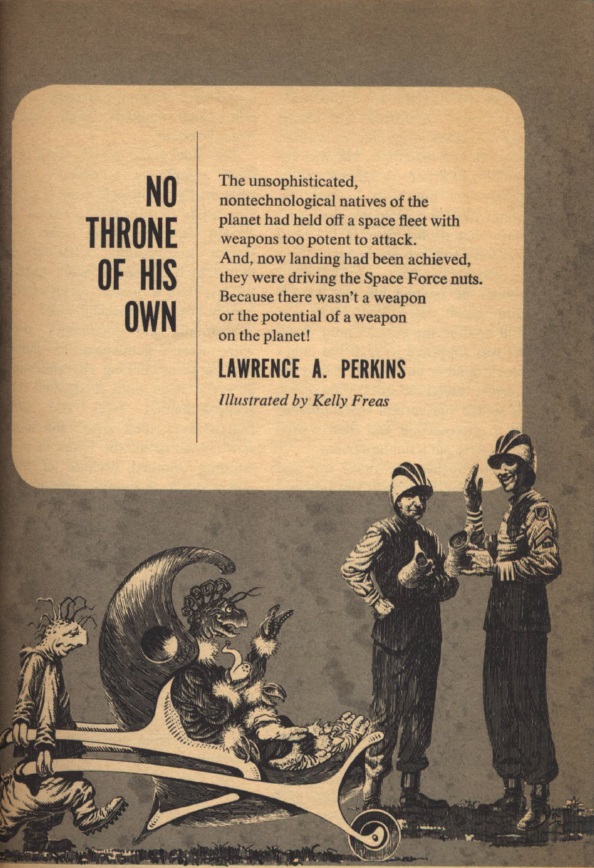
by Kelly Freas
Worse is the second "funny" story of this issue, by a brand new author. Something about a human Private on an alien world whose experience with the local booze leads him to understanding how a Terran invasion was at first thwarted and later welcomed. I think. Truth to tell, it was a confusing mess, and I skimmed it as a result.
One star.
The Space Technology of a Track Meet, by Robert S. Richardson
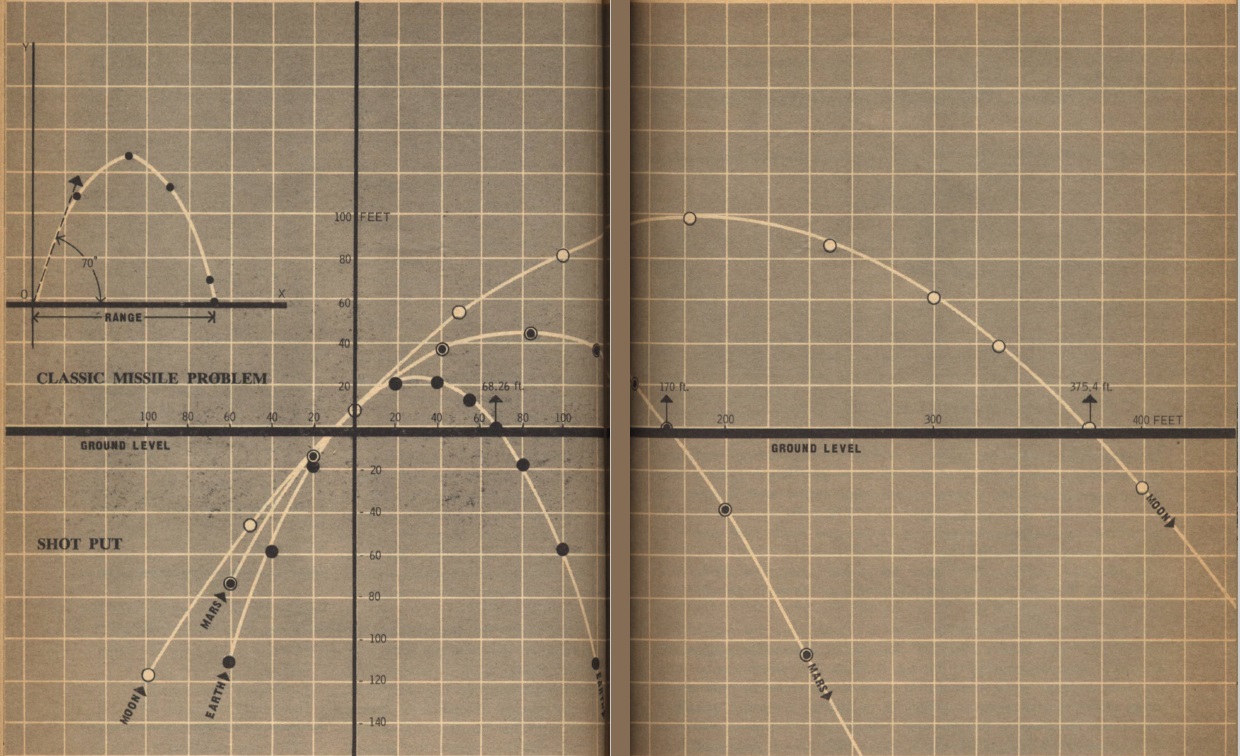
A saving grace of this issue is the nonfiction article by the reliable Richardson. He apparently spent a few weeks doing some complicated math to see how athletes might really perform at sports on planets of different gravities.
Useful, interesting stuff — I just wish he'd included more equations for easier following along.
Four stars.
The Prophet of Dune (Part 4 of 5), by Frank Herbert

by John Schoenherr
Last up, we have the humorless, plodding fourth installment of Part Two of the Dune saga. With no transition whatsoever, the setting changes to two years after the last installment. Paul Muad'Dib, son of the late Duke Leto Atreides, is still hiding out with the desert-dwelling Fremen, harvesters of the geriatic melange spice of Arrakis. A vassal of the nefarious Harkonnen Barony, who usurped the Atreides claim two years prior, is slowly losing control of the planet, and the Fremen are anxious to strike. But before Paul can lead his ragtag army in revolt, he must become a full Fremen, which requires that he mount the titanic Makers — the sand worms of Arrakis.
Meanwhile, Paul's mother, Lady Jessica, now the Reverend Mother of the Fremen, deals with the fallout of her transforming spice poison into liquor in her system after ingestion during her induction ceremony two years prior. For her unborn daughter, Alia, was imprinted with all of Jessica's experience, which also includes that of all the Reverend Mothers of the Fremen before her. Alia is, thus, a toddler burdened with several lifetimes of knowledge…much like her brother, Paul, due to his spice-given precognitive skills. This makes her a feared freak, though what role she has to play in the saga is yet unknown.
There are some interesting bits, but for the most part, a could-be fascinating epic is marred by amateur writing, some laughable errors ("A head popped up into the con-bubble beside Gurney — the factory commander, a one-eyed old pirate with full beard, the blue eyes [emphasis added] and milky teeth of a spice diet."), and the damnable constantly switching viewpoint.
A very low three, I guess.
After Action Report
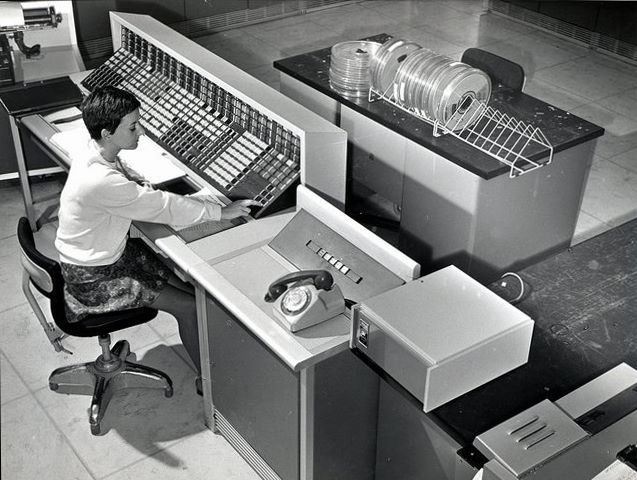
In the end, dreary as it was, Analog was far from the worst SF mag this month. Though it only scored 2.6 stars, it was surpassed in lousiness by Amazing, IF (2 stars), and Gamma (1.9 stars). Galaxy was a little better (2.7), followed by Science Fantasy and Fantastic (2.8), and then Worlds of Tomorrow (2.9). Only New Worlds Fantasy and Science Fiction made it to orbit, and only just — 3 and 3.1 stars, respectively.
As with the real Space Race, women are mostly (though not entirely) unrepresented; only Jane Beauclerk and the amazing Zenna Henderson were published this month. Perhaps more women astronauts…er…writers can rescue us from this dark chapter in our genre.
One can but hope!
We had so much success with our first episode of The Journey Show (you can watch the kinescope rerun; check local listings for details) that we're going to have another one on April 11 at 1PM PDT with The Young Traveler as the special musical guest. As the kids say, be there or be square!



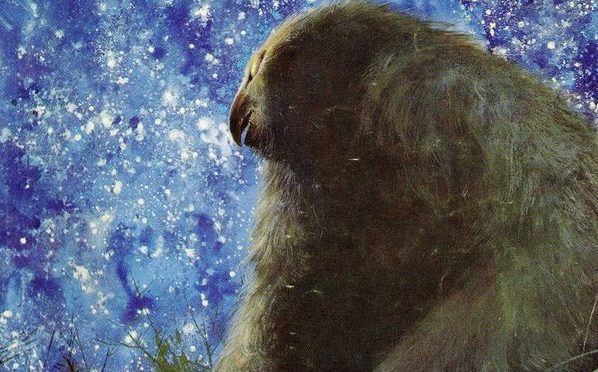

I really enjoyed "Goblin Night". It did go on a little long (while at the same time ending rather abruptly), and I suppose Telzey was undercharacterized here. Some of that might have been due to her being a bit of an outsider in the group. She wasn't mixing well, despite the presence of her "fan club".
"Fad" was just awful. Not quite as bad as "Good Indian", but close. His faux Damon Runyan slang was pretty bad, too. Reynolds is a much better writer than this.
"Throne" was also terrible. Less offensive than "Fad", but probably worse overall. I think the protagonist was meant to be the sort of soldier with low cunning who manages to do just enough to avoid being charged with dumb insolence (as the Brits put it in the last century) and usually has some sort of scam running. That or he's just lazy and stupid.
The fact article was interesting, and a darn sight better written and more factual than most in Analog. Alas, I think Mr. Richardson has made a fatal error in most of his calculations. He seems to have completely disregarded the fact that there is a vertical vector in walking/running as well as a horizontal vector. He gives a brief nod to it when discussing movement by bounding, but seems to think that that will only apply in very low gravity. I think both the Moon and Mars will be subject to that, while racers on high gravity worlds may be even slower than he suspects as they only manage to shuffle along. It's also going to affect the way shot putters and jumpers gain momentum.
I continue to like the Dune stories better than you do, while still seeing some of the problems. Oddly, the time jump might be less jarring in a novel than it is here in the serial. An intervening page with PART II or something would better prepare the reader for it. On the other hand, it also reflects some of Paul's difficulties knowing just when he is at any given moment. Also, last month's wonderful cover would have gone much better with this installment. Anyway, somebody get Herbert a proper editor for these. Compare this to "Greenslaves" under Cele Lalli's direction.
Gideon —
I can't argue with any of your critical calls re. this issue of ANALOG .
However, as regards the POV-jumping in mid-scene in Herbert's DUNE, the truth is that this was a perfectly accepted literary convention in many 19th-century classic lit novels. Moreover, it still occasionally gets used by modern literary writers.
In today's commercial and pulp-descended fiction, on the other hand, it's verboten and only complete tyros use it (and they don't escape the slush pile). You also won't see it in our current literary bestsellers from the likes of messrs. Saul Bellow, John Updike, or Norman Mailer.
With good reason, I feel. It's not realistic and you can't do any of things with limited/unreliable narrators that literary authors have been doing since Henry James (forex. 'The Turn of the Screw'), Joseph Conrad, and Ford Madox Ford (forex. THE GOOD SOLDIER).
Nonetheless, the 'jumping-heads' convention _was_ acceptable for 19th century social panorama novels. Given the similar scale of what Herbert seems to be going for in DUNE, that may be why he uses the convention.
He doesn't do it in his other novels and, even if he was a tyro, John W. Campbell isn't — whatever Campbell's other faults, he's been a professional editor and writer in the commercial fiction market since the 1930s. So it's possible that he and Herbert had this debate, and made a conscious choice to allow the 'head-jumping.'
"Goblin Night" wasn't bad, although it's really just another variation on "The Most Dangerous Game."
"Fad" was like a really weak imitation of a 1950's Galaxy satire.
"No Throne of His Own" was tedious.